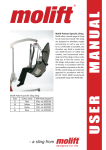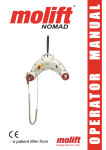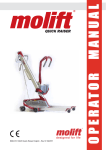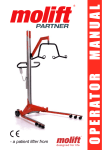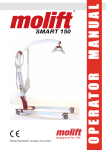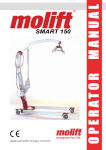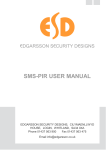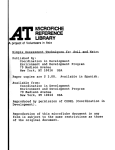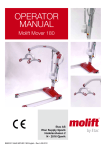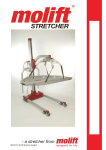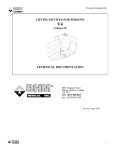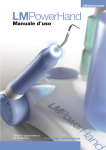Download Brukerveiledning MOLIFT Smart
Transcript
- a patient lifter from Table of contents General advice.................................................. 3 Explanation of symbols................................ 3 Before using the patient lifter....................... 3 Responsability.............................................. 3 Accessories..................................................... 16 Lifting sling................................................. 16 Sling size guide. ...................................... 16 Easy Scale........................................................ 17 Main parts.................................................... 5 Safety devices.............................................. 5 Safety instructions...................................... 17 Cleaning..................................................... 17 Start-up...................................................... 17 Weighing.................................................... 17 Error messages.......................................... 18 Changing the unit (kg <-->Lb).................... 18 Enhanced functions (Interactive mode)...... 18 Setting/Modifying the OFF time (Power Off).. 18 Filter settling / filter change........................ 19 Technical data................................................... 6 Maintenance. ................................................... 20 Safety precautions........................................... 4 General........................................................ 4 If defects or faults occur............................... 4 Lift and transfer............................................ 4 About the product............................................ 5 Assembly / disassembly................................. 7 Assembly and use of charger....................... 7 Assembly...................................................... 7 Checklist before use..................................... 7 Disassembly................................................. 7 Operation............................................................ 8 Battery care.................................................. 8 Battery capacity............................................ 8 Battery types and chargers.......................... 8 Operating the hand control........................... 8 Emergency stop and lowering...................... 9 Lifters with manually lowering function......... 9 Lift and transfer............................................ 9 Use of spread legs..................................... 10 Using lifting slings...................................... 10 Lift and movement to and from bed............11 Lift from bed.............................................11 Lift to bed................................................ 12 Removing the sling. ................................. 12 Lift and transfer to and from floor............... 12 Alternative lift 1........................................ 12 Alternative lift 2........................................ 13 Lowering to floor...................................... 13 Lift and transfer to and from (wheel)chair.. 13 Lift and transfer from (wheel)chair. ............ 13 Lift and transfer to (wheel)chair................. 14 Removal of sling...................................... 14 Bathing....................................................... 14 Toileting...................................................... 14 Alternative............................................... 15 Page of 24 Daily maintenance...................................... 20 Monthly maintenance................................. 20 Fault finding................................................ 20 Service / yearly maintenance .................... 20 IMPORTANT! The patient lifter is only meant to be used by qualified personnel. The manual shall not be handed over, or made available to, any unauthorised third party, without a prior written consent from Molift AS. Exciting laws, conventions and agreements protects all documents. No extract of this documentation can be reproduced, used or transferred without prior written consent from Molift AS. Violation of these regulations may lead to judicial repercussions and economic responsibility. Industrial rights are reserved. Molift AS Ole Deviksvei 44 0668 OSLO, Norway Teleph:(+47) 40001004 Fax: (+47) 40001008 www.molift.com [email protected] E Rev. H/ 09/2006 General advice Responsability Please read these operating instructions carefully This user manual contains important safety instruc- before putting the product into operation. We astions and information regarding the use of the lifter. sume no liability for damage or malfunctions reCarefully read the manual before using the lifter in sulting from failure to comply with the instrucorder to be familiar in the function and use of the tions. Warranty claims must be made immediately lifter. on detecting the defect. Remember to quote the serial number. Consumable parts are not subject to the Explanation of symbols warranty. This symbol is used to point out instructions and information related to work place safety where injury may occur if the information is disregarded or ignored. Follow these instructions, be careful and attentive at all times. This symbol indicates important information regarding the use of the equipment. If not taken into consideration, it may lead to damage or functional defects to the lifter or other equipment. This symbol indicates important and useful information. If taken into consideration, it will help the operator of the lifter to work efficiently. It may help simplify routines and to explain complicated facts. Before using the patient lifter Before using a patient lifter, the operator must be trained accordingly. Practice lifting a colleague, and be lifted by others. It is important not only to know how to move another person using the lifter, but also how it is to be lifted. Try out and practice using all the relevant slings for the different types of lifter and movement you may encounter. Before lifting a person, you should explain the procedure. When using the lifter, it’s also important to use the correct sling and accessories according to: • • • • type of disability size weight type of movement All technical information, data and instructions for operation contained in these operating instructions were up-to-date at time of print and are compiled on the basis of our experience and to the best of our knowledge. We reserve the right to incorporate technical modifications within the scope of further development of the product described in this manual. No claims can be derived from the information, illustrations or descriptions contained in these instructions. We assume no liability for any damage or malfunction caused by operating errors, non-compliance with these operating instructions or inappropriate maintenance. We expressly point out that only genuine Molift AS spare parts and accessories approved by us may be used. For safety reasons, the fitting and use of spare parts or accessories, which have not been approved, and unauthorised modification or conversion of the product, are not permitted. Molift AS will accept no liability for damages resulting from such acts. With the exclusion of product liability, Molift AS is liable for faults or omissions on its part within the scope of the warranty obligations stated in the purchase contract. Claims for damages are excluded, irrespective of the legal reason from which such claims are derived. Only documentation belonging to the actual equipment is valid. Any failure to comply with the safety regulations and precautionary measures stated in these operating instructions renders the declaration of conformity supplied with the system in accordance with Council Directive (93/42/EEC) concerning medical devices invalid. Page of 24 Safety precautions General Before putting a Molift SMART into operation, the operator must ensure that the lifter and accessories are in good working order, especially with regards to safety. All instruction and information in this manual regarding safety and general precautions must be read, understood and followed carefully. Any disregard to these precautions may result in personnel injury or damage to the equipment. The lifter must be taken out of service immediately, or not returned to service, if faults and/or irregularities that may have influence on the safety are discovered. Injury to personnel or equipment may occur if Molift SMART is used in an incorrect manner and if: • • • • covers are removed by unauthorised personnel used incorrectly insufficient maintenance load exceeds maximum limit. The maximum load stated in this manual and on the lifter is the maximum load • unauthorised repair of electrical devices or cables Lift and transfer The patient lifter may tip over if used incorrectly! Ignorance of warnings and instructions may lead to personnel injury. Read instructions carefully before attempting to lift anyone. Safety devices and -equipment must not be removed, disabled or in any other way altered. A Molift SMART shall only be used when all safety devices and equipment is in place and fully operational. Several factors have to be considered during movement of the lifter: The lifter is designed for use in room temperature, +10 to +40 °C. This should be • the user shall sit as low as possible facing the taken into consideration when transporting lifting column the lifter, and therefore keeping it in a tem- • the user should rest their feet on the chassis perate part of the vehicle. Alternatively, the lifter must rest in a temperate room until the Stand to the side of the user when lifting. Ensure that equipment has achieved proper working tem- arms and legs are clear of the lift, chair, bed etc. Try perature. to maintain eye contact with the user - this will help the user feel safe and comfortable. If defects or faults occur The lifter must be switched off immediately if one Pay close attention to your actions. Ensure that all four loops of the sling are securely of the following conditions occur; fastened to avoid the user slipping or falling • damage to electrical devices or cables, or damage to parts of electrical insulation Use the drive handle to manoeuvre the lift, do • damage or failure on safety devices NOT attemt to manoeuvre the lift by pushing on the lifting arm, actuator or patient. If the lifting movement does not start when the corresponding button is pressed, please Molift slings shall ONLY be used to lift perconsult the fault finding table in the maintesons. NEVER use the sling to lift and/or move objects of any kind. nance chapter to locate the fault. Page of 24 E Rev. H/ 09/2006 About the product The lifting arm is joined to the top of the lifting column and the battery driven actuator provides the Molift SMART is a foldable mobile lifter intended lifting movement. At the end of the lifting arm, you for lifting and transferring personnel. The lifter is will find the suspension with four hooks to attach made out of light materials, it has castors and a bat- the sling. The suspension rotates freely, allowing the tery. It is therefore ideal for mobile care units, such Molift SMART to be used at any angle. as home care personnel who has a need for lifting capabilities without fixed or stationary lifting devic- Safety devices es present in every home. The lifter has intelligent Molift SMART is equipped with several safety deelectronics with softstart, two speeds and a counter vices, which are intended to prevent damage to perto register the number of lift cycles. sonnel and equipment in the case of incorrect use. Main parts • The lifter has an overload sensor preventing the The lifter is built around a chassis unit comprislifter to be operated with more the maximum ing a lifting column fixing bracket, rear castors and load. If the load exceeds the maximum limit, the spreading mechanism for the legs. The lifting collifter will stop the movement. umn can be rotated in the fixing bracket, allowing • The lifter has a safety feature to prevent the liftthe lifting column to fold down to a horizontal posiing arm and suspension from squeezing a user if tion during transport, in addition to the near vertical lowered to much. The actuator will not produce position used during lifting. any force in downward movements. • The legs are folded together during transport to A drive handle used for transferring the lifter is situmake the lifter as small as possible. When assemated at the top of the lifting column. A battery holdbling the lift, the legs must be spread to working er containing the control electronics is placed at the position. A safety feature will prevent the lifting right side of the lifting column. The battery holder column to be fixed in the bracket before the legs also features an emergency stop button, LED indiare spread beyond transport position. cator, emergency lowering switch and contacts for • The suspension has safety hooks to prevent the the hand control and actuator. The adjustable legs sling loops to fall off. are operated by pedals and give the operator the pos- • The electronics are disabled if the temperature sibility to adjust the width of the lifter to different rises beyond a critical limit. needs and situations. Drive handle Lifting arm Actuator Lifting column Battery holder / control electronics Suspension Chassis Emergency stop Adjustable legs Pedals for adjusting the legs Lifting column fixing bracket Page of 24 Technical data Lifting capacity (maximum): Weight, total: Lifting height: Material: Height of legs: Motor: Measurement, transport: Ex. battery; 25 kg / incl. battery: 25,8 kg Battery: Steel and aluminium 12 VDC 14,4 V NiCd 1,9 Ah or 14,4 V NiMH 2,2 Ah, Molift Power Pac Page of 24 150 kg 0 - 750 mm below user Max 110 mm 1160 x 475 x 350 mm (LxWxH) Measurement, assembled: 1160 x 1060 mm (LxW) Measurements in illustrations below are in millimetres. E Rev. H/ 09/2006 Assembly / disassembly To be able to operate the lift, the operator must have good knowledge of the lift, including assembly, disassembly and preparation before use. Ensure that the lifting column is properly fixed and that the locking handle at the base of the lifting column is properly tightened. Disassembly • Run the lifting arm all the way down while holdAssembly and use of charger ing the suspension up towards the lifting arm alThe battery charger shall be mounted on a vertical lowing the suspension to be placed into the transwall surface close to a power outlet. The charger port hook. shall be connected to the power outlet at all times. Molift AS tests and charges all batteries before packing and shipment. However, all batteries must be charged before use. Assembly • Open the bag (if used) and lift out the lifter • Remove the transport elastic and spread the legs to initial operating position • Lift up and rotate the lifting column and press it down into the bracket as shown in the illustration below (1). • Remove the battery from the lifter to avoid it falling out during transportation. The control electronics are active as long as the battery is placed in the holder. If the lifter is to be stored for a longer period, the battery should then be removed (or emergency stop activated) to avoid unnecessary discharge of the battery. • Open the locking handle, lift up the lifting column (grab with both hands and lift straight up) and rotate it to transport position. • Fix the lifting column in place by rotating the locking handle down (2). • Insert the battery into the battery holder and verify that the emergency stop button isn’t activated. • Lift the suspension out of the transport hook and raise the lifting arm up to desired working elevation. Do not start to run the lifting arm before the suspension is released! Checklist before use • Check that the lifter has no apparent damage or other faults • Check that you have sufficiently charged batteries to complete the task you have planned The lifter can be split into two parts by lifting the column from the chassis completely. The lifting column/-arm and the chassis with legs are then separate parts. Be careful not to get legs/arms/hands wedged between the parts when folding down the lifting column/-arm. • Fasten the hand control to the driving handle • Press the legs together and secure legs and lifting column/-arm with the transport elastic. • Put the lifter into the bag. Page of 24 Operation The chargers have different ways of showing the status of the charging process. Battery care Molift PowerPac system is a battery with a 14,4 V • NiCd-charger cell unit that is placed in the battery holder on the The charger has a LED indicating the status of the lift. A charger is also supplied to charge the battery battery as described below: whenever needed. This battery system is the same LED Mode Output on all of Molift’s mobile lifts. The power cable of Yellow No battery 25 V the charger should be connected to the power outlet Yellow Initalization (10 sec) 100 mA at all times (verify that the charger is suitable for the Orange Fast charge 1,8 A local power system voltage). Place the battery in the Green/yellow Top-off charge 270 mA holder according to the arrow markings. Press the Green Trickle charge 100 mA battery gently down to ensure good contact between Orange/green Error 100 mA battery and charger. Battery capacity It is recommended that NiCd batteries are placed in the charger when not in use. RegA LED (Light Emitting Diode) is situated on the batularly (each 10 times) the battery should be tery holder. If the voltage of the battery falls below used until the charging indicator on the lifter a certain level, the diode will change to orange, inglows, before charging the battery. dicating the need for charging. There is still enough capacity to perform 3-5 lift cycles (75 kg) at this point. If the battery is discharged during a working • NiMH-charger session, it’s recommended to have two batteries, so The charger has two diodes - a green and a red. The a second charged battery is available when needed. red diode will glow as soon as the battery is placed in the charging unit and maximum charging current If the battery is discharged during a lift, it is is applied. The green diode will start to glow when always enough power to lower the user down the battery is fully charged and the charger switchagain. es to maintenance charging. If the charger can’t detect fully charged battery after about 8 hours, a Battery types and chargers built in timer will force the charger to maintenance Molift PowerPac can be used with two kinds of bat- mode to avoid overcharging. teries; NiCd and NiMH. Operating the hand control The battery and charger types must not be The hand control has four buttons (high/low speed mixed. Use of wrong charger to battery type up and high/low speed down) which gives the opermay cause overheating and damage to the ator excellent control over the lift. Powerpac High speed up Be aware that these two batteries have different chargers. Follow the instructions printed on the battery. High speed down It’s not possible to overcharge the batteries, Low speed up but to ensure optimal performance throughout the lifetime of the battery, we recommend Low speed down that the battery is allowed to rest for a couple of minutes after charging to cool down The control electronics has a power saving feature, before use. It is also important that fully which puts the system into stand by after about two charged batteries are not charged without minutes of inactivity. beiing used. Page of 24 E Rev. H/ 09/2006 Emergency stop and lowering Lift and transfer All of the Molift patient lifts are equipped with The suspension shall always be positioned across emergency stop and lowering. The emergency stop the user as shown left in the illustration below. will cut the power to the actuator, and is situated on the battery holder on the lifting column. Turning it clockwise until it pops out will reset the emergency button. It is possible to perform an emergency lowering of the lifting arm in case of a general malfunction of the control electronics. The button can be found on the battery holder under a yellow sticker seal. If you need to perform an emergency lowering, move the lifter to a suitable location to lower the user. • Press the emergency stop button and leave it. • Puncture the seal and press the emergency lowering button. The lifting arm will then perform a smooth downward movement. • If the lifter still do not work, change battery and try the emergency lowering procedure again. • If it still does not work, the suspended user must be lifted out manually. Request assistance. When using slings intended for two point suspension, the suspension shall be used diagonally, i.e. loops from the sling shall be fastened on hooks diagonally opposite. Try to position the user as low as possible (preferably resting the feet on the chassis) when transferring the lifter with a suspended user. In this way, the centre of gravity will be as low as possible and therefore reducing the risk of instability. The lifter should Contact your Molift service partner if the be manouvered with spread legs in outer position to reason for the failure causing an emergen- achieve the highest possible stability. cy lowering is unknown or if it is a result of failed components or parts. Be careful during movement - the suspended user may swing somewhat during turns, stops and starts. Lifters with manually lowering function Be particularly careful when manoeuvring close to The manually lowering function on the actuator is furniture to prevent the suspended user from collidonly to be used if the electrical lowering does not ing with these objects. work. The lifter shall not be used to lift or move users on sloping surfaces. Handle for manually lowering Pull the red handle slightly upwards. Take care, the lifter moves faster when activating the handle more. The lifter will stop dead with a danger of personal injury and damage on the lifter if the handle is released suddenly. Avoid deep pile carpets, high thresholds, uneven surfaces or other obstacles that may block the castors. The lifter may become unstable if forced over such obstacles increasing the risk of tipping over. The lifter shall only be used for movement over short distances. It is not a replacement for wheelchair or similar. Page of 24 Use of spread legs Sling without head support Use wide legs wherever appropriate, for instance to position the lifter around wheelchairs, toilets etc. • To spread the legs, - press (pump) the right pedal on the chassis. • To narrow the legs, press (pump) the left pedal. Sling with head support Using lifting slings The Easy lifting slings are, as the name indicates, easy to use. They are washable at 80º C and autoclave at 85 ºC for 30 minutes. The plastic insert of the head support should be removed before washing. It is recommended to use Molift Easy slings. Slings from other manufacturers may have other specifications leading to unexpected instability and possible injury to personnel. Please see the user manual that comes with the sling for spesific instructions. Fold the sling as indicated above before use. The grey side should be facing away from the user when putting the sling in place. The sling should be held by one hand, leaving the other free to move and support the user Torn, cut, frayed or broken slings can fail, resulting in serious injury to the user. Use slings in good condition only. Destroy and discard old, unusable slings. Page 10 of 24 E Rev. H/ 09/2006 Lift and movement to and from bed Lift from bed Roll user onto her side. Put the folded sling behind her back. The centre of the sling should be parallel with the users spine. Roll her then onto her back. If the user has a bed which enables raising and lowering, it should be lowered before the lifting starts. Position the legs under the bed with the suspension over the user. Be careful not to lower the suspension too low touching the user. Make sure that the suspension is centred over the user before you start the lifting. Remember - the castors should not be locked. Pull the leg loops forward and under the thighs as shown. When all four loops are hooked onto the suspension, raise the user carefully. If the user is in a hospital bed, it will help to raise the head of the bed Cross the loops, one through the other. Repositioning of the user may be needed to ensure that a safe and comfortable sitting position is attained as the user is raised. Reposition using the handle on the back of the sling. Page 11 of 24 Lift and transfer to and from floor Lift and transfer from the floor is almost identical to a lift and transfer from bed - please read this section. There are two ways to lift from the floor. Alternative lift 1 Raise the user until the buttocks are just above the mattress. Lift the user’s legs and turn her so she faces the lifting column. When clear of bed, and if practical, lower the user so that her feet rest on the chassis. If possible, lower the bed before lifting. Move the lifter away from bed. Beware of obstructions under the bed that can cause castors to stop or tip Lift to bed Place the sling as if in bed. Gently position the lifting column between the legs of the user as shown above. The suspension shall be centred over the user. Lower the suspension enough to allow the sling loops to be hooked up. Centre the user over the bed and turn her so that the feet point to the foot end of the bed. Lower the user carefully. Remove the loops from the suspension. Removing the sling Gently pull leg section to the side, out from the user’s thighs and towards yourself. Pull the shoulder section under the neck of the user and roll her gently onto her side. Pull the sling away and roll her onto her back. Raise the user from the floor. Position user in the sling by pulling the handle on the back of the sling. Be careful when rolling the user onto her Turn user to face the lifting column, and place the side. Make sure you have control over the feet on the chassis. movement to prevent her from rolling completely over and out of the bed. Page 12 of 24 E Rev. H/ 09/2006 Alternative lift 2 A floor based lift may also be performed by gently positioning the users head on the chassis. Use a pillow if appropriate to protect the head and neck of the user. Otherwise as alternative 1. Lowering to floor Place a pillow on the chassis or on the floor to protect the users head and neck (not necessary if you are using a sling with head support). Otherwise as described above. Lift and transfer to and from (wheel)chair Lift and transfer from (wheel)chair Fold the sling as described in ”Using lifting slings” The leg sections of the sling are pulled forward and beneath the user’s thighs by the loops. The loops are then crossed, one through the other, as shown. If the users physique and ability allows it, the user should be encouraged to take active part in fitting the sling. The user can lean forward, lift her thighs and help placing the leg section. Move the lifter around chair. Lean the user forward gently, but ensure you continue to support her. Place the folded sling behind the user’s back and push it down until it touches the seat of the chair. If the transfer is from a wheelchair, the brakes must be locked to prevent the wheelchair from rolling away. Raise/lift user above seat height, and perform the transfer. It is not necessary to lift the person very high. Page 13 of 24 Lift and transfer to (wheel)chair Manoeuvre the lifter so that the user is as far back in the (wheel)chair as possible. If the users physique and ability allows it, the user should be encouraged to take active part in fitting the sling. The user can lean forward, lift her tights and help placing the leg section. If the transfer is from a wheelchair, the brakes must be locked to prevent the wheelchair from rolling away. Bathing The procedure for lifting to/from the bath is in prinWhen lowering, you can use the following tech- ciple the same as for to/from bed. A special bathing niques or a combination of them to position and get sling is used for this purpose. This sling dries quickthe user seated far back in the chair. ly and may be washed at 80 ºC. • push gently on the knees • pull the loop on the back of the sling • tilt the chair slightly backwards Lower the user into chair, unhook sling from suspension and remove the lifter. The lifter is not waterproof. Avoid direct exposure to water. Toileting Removal of sling Gently pull leg section to the side, out from the user’s thighs. Standing by the side of user, lean her forward - supporting with one hand. Pull sling up from behind her back. The Molift Easy Toilet Sling is used with the standard 4-point suspensions. Molift Easy Toilet sling is a toilet sling with a thicker and wider upholstery. It is also available with head-support. The Molift Easy Toilet Comfort sling is easier to fit in narrow environments, and is available with a separate head support The toilet sling can be washed at 80 ºC, and is fitted as follows: Pulling sharply on sling may cause user to fall forward resulting an injury. Always support the user by keeping one arm around the user’s shoulder when fitting or removing the sling (see illustration). Page 14 of 24 • Insert the sling behind the users back with the grey side away from user. • Fasten the belt firmly around the user’s body. E Rev. H/ 09/2006 • Place the leg section under the front part of the thighs and pull the loops up between the thighs. Alternative By pulling the leg sections from the outside and in, you will achieve a wider leg position. • On Molift Easy Toilet Comfort, place the leg section over and down between the thighs and pull outwards from the inner part of the thighs. The leg sections of Molift Easy Toilet Comfort Sling are fitted to separate the legs, therefore they should not be crossed as the other Easy slings. • Hook the four loops on the suspension as for other slings. • Position the lifter around the toilet and lower the user. • Pull the leg sections out of the way. The sling can be left on during bathroom use. Page 15 of 24 Accessories Molift Easy Toilet Sling Comfort Lifting sling Molift Easy Paediatric Sling Size No headsupport Separate headsupport XXS Art. no 3016050 Art. no 3016055 Art. no 3016000 Art. no 3016001 Size No headsupport With headsupport XS XXS Art. no 3005050 Art. no 3006050 S Art. no 3016100 Art. no 3016111 XS Art. no 3005000 Art. no 3006000 M Art. no 3016200 Art. no 3016222 L Art. no 3016300 Art. no 3016333 XL Art. no 3016400 Art. no 3016444 XXL Art. no 3016500 Art. no 3016555 Easy Toilet Sling and Basic Bathing Sling for kids, see the tables below, size XXS and XS. Molift Easy Sling Molift Easy Amputee Sling Size No headsupport With headsupport XS Art. no 3025000 Art. no 3026000 Size No headsupport With headsupport Art. no 3027050 Art. no 3028050 S Art. no 3025100 Art. no 3026100 XXS M Art. no 3025200 Art. no 3026200 XS Art. no 3027000 Art. no 3028000 L Art. no 3025300 Art. no 3026300 S Art. no 3027100 Art. no 3028100 XL Art. no 3025400 Art. no 3026400 M Art. no 3027200 Art. no 3028200 XXL Art. no 3025500 Art. no 3026500 L Art. no 3027300 Art. no 3028300 Molift Basic Sling Size No headsupport With headsupport XXS Art. no 3021050 Art. no 3022050 XS Art. no 3021000 Art. no 3022000 S Art. no 3021100 Art. no 3022100 M Art. no 3021200 Art. no 3022200 L Art. no 3021300 Art. no 3022300 XL Art. no 3021400 Art. no 3022400 XXL Art. no 3021500 Art. no 3022500 XL Art. no 3027400 Art. no 3028400 XXL Art. no 3027500 Art. no 3028500 Bag for slings - Art. no 3048000 Transport bag for Molift SMART lifter w/batteries. Sling size guide A C B Molift Basic Bathing Sling Size No headsupport With headsupport XXS Art. no 3023050 Art. no 3024050 XS Art. no 3023000 Art. no 3024000 S Art. no 3023100 Art. no 3024100 M Art. no 3023200 Art. no 3024200 L Art. no 3023300 Art. no 3024300 XL Art. no 3023400 Art. no 3024400 XXL Art. no 3023500 Art. no 3024500 Molift Easy Toilet Sling Easy and Basic Slings Size Color code Recomm. weight (Kg) A (cm) B (cm) C (cm) XXL White 230-300 86 130 68 XL Blue 160-240 76 115 66 L Green 90-160 66 100 64 M Yellow 45-95 56 85 62 S Red 25-50 51 75 60 Art. no 3033300 XS Light blue 17-25 46 65 58 Art. no 3032400 Art. no 3033400 XXS Pink 12-17 41 55 56 Art. no 3032500 Art. no 3033500 Size No headsupport With headsupport XXS Art. no 3032050 Art. no 3033050 XS Art. no 3032000 Art. no 3033000 S Art. no 3032100 Art. no 3033100 M Art. no 3032200 Art. no 3033200 L Art. no 3032300 XL XXL Page 16 of 24 Choice of sling size depends on both user weight and shape/size of user. E Rev. H/ 09/2006 Easy Scale The maximum scale loading must not be exceeded. The safety requirements and the notes on appropriate use provided by the lifter and the system manufacturer must also be observed. • Display segment test (~5 seconds) please wait Safety instructions Please comply with the maximum capacity of the scale which is stated on the identification plate on the back of the device. • Switch on the scale • then all segments go off (~2 seconds) • Automatic zeroing 1) (~3 seconds) • The scale is ready to use. Now you can weigh. This device meets the requirements under 90/384/ EU and 73/23/EU and is interference--suppressed 1) If the initial loading of the scale (tare) exceeds20 % of the weighing range, automatin accordance with the currently valid EU directive, ic zeroing does not take place. In this case, 89/336/EU. The device must not be modified from tarring has to be performed manually. (See the design or safety engineering point of view except chapter Taring/Additive weighing.) the supplier express agreement. Any modification shall exclude all liability on the part of the supplier for any damage resulting therefrom. It is strictly for- Taring / Additive weighing bidden to carry out any repairs and soldering work Switch on the scale and wait ~10 seconds . on the motherboards or to replace any components. Add the weight to be tared (e.g. belt) Repairs must only be undertaken by persons who are authorized and qualified to do so. • Taring Cleaning Just wipe gently with a damp cloth, do not use any abrasive or caustic cleaning agents. • Now you can weigh / weigh by addition.2) Start-up Unscrew the right--hand cover, insert the battery case with batteries (4x 1.5 V-type AA) according to the polarity indicated! Push the tray into the battery compartment and screw the cover down again. The scale is now ready to use. 2) Keep pressing the G/N key to toggle between the scale zero and the gross weight Batteries do not belong in domestic waste. Please hand in used batteries to public collection points or dispose of them through the trade. Weighing Switching on / Weighing The scale is ready to use about 10 seconds after it is switched on. During this time, the scale must neither be moved nor loaded Add more of the weight to be tared • Taring 3) • Now you can weigh/ weigh by addition. 3)The first time the G/N key is pressed, the current total (gross) weight is displayed. Taring occurs when the G/N key is pressed again. You can repeat this as often as you like until the maximum weighing range of the scale is reached. Page 17 of 24 Enhanced functions (Interactive mode) Switching off • Press the ON/OFF key to switch off the scale. Error messages Overload Overload Battery status • Scale overloaded! Please comply with the nominal (rated) load for the scale (see identification plate on the back of the device) Setting/Modifying the OFF time (Power Off) • Switch on the scale and wait ~10 seconds (see chapter switching on/raging). • Simultaneously pressing the ON/OFF and G/N keys enables interactive mode. press simultaneously Interactive mode (Standard Function) • Switch the scale off and on again. OFF time (Power Off) • Select by repeatedly pressing the ON/OFF key (digit flashes): Can only be switched off manually (by means of the ON/OFF key) Switches off automatically after 30 secs. (only if the scale is unloaded) Switches off automatically after 60 secs. (only if the scale is unloaded) • The batteries are flat and must be replaced! 4)Non-legal-for-trade scales can be used for weighing for a short time after the battery symbol appears. To prevent measurement error, however, the batteries should be replaced at once. Changing the unit (kg <-->Lb) (Only possible with non-legal-for-trade scales.) • Confirm the selection with the G/N key. . • Switch on the scale and wait ~10 seconds (see chapter switching on/raging). Unit kg At this point, you can check or change PO by pressing ON/OFF again • Keep pressed for ~5 seconds Unit Lb (American pound) The same method is used to change from Lb to kg. The last unit set is retained even when the scale is switched off. Page 18 of 24 1 x press: Filter setting AF (see next page) or 2 x presses: back to weighing mode or E Rev. H/ 09/2006 Filter settling / filter change Stabilizing the weight display • Switch on the scale and wait approx. 10seconds (see chapter switching on/raging). • Simultaneously pressing the ON/OFF and G/N keys enables interactive mode. press simultaneously Interactive mode (Standard_Function) Filter setting (Amplifier Filter) • Select by repeatedly pressing the ON/ OFF key (digit flashes): 0 = Filtering switched off 1 = weak filtering: + very fast weight display - unsteady display while moving 4 = average filtering (recommended): + fast weight display + steady display 8 = very strong filtering: + Possible to weigh unsteady people - long waiting time until the weight or the zero-point of the scale is displayed steadily • Confirm the selection and adopt the settings with the G/N key • At this point, you can check or change AF by pressing ON/OFF again. • back to weighing mode² Now you can weigh. Page 19 of 24 Maintenance Daily maintenance Detergents must be pH-neutral. Do not use solvents or strong liquids - this may damage surfaces on the lifter. For disinfection when needed; use isoproply alcohol. Avoid abrasive cleaning products. Clean surfaces with a damp cloth using an appropriate detergent. Monthly maintenance • Remove hair and pile from the castors and verify that the castors rotates without abnormal friction • Verify that the contacts of the hand control and charger is firmly in place • Clean contact and hand control with spirit or similar to remove grease and dirt • Verify that the cables for the hand control, actuator and charger are intact • Run the lifter up and down to verify that it runs normaly and without any abnormal noise Fault finding Symptom Possible cause/action The lifting column is wobbly Locking handle is loose and must be tightened or the lifting column is out of position in the bracket / verify position of lifting column and tighten locking handle Lifting arm (actuator) does not move Battery is empty / change to a new battery or charge battery Emergency stop activated (button is pressed in) / turn knob clockwise to reset The cable/contact of the actuator or hand control has disconnected / reconnect contact(s) Hand control has failed / switch to another identical control if available or contact local service representative for service Defecive control electronics / contact local service representative for service Actuator is defective / contact local service representative for service Service / yearly maintenance If you are not able to solve the fault or problems by yourself using this manual, please contact local authorised service representative. If you do not know whom to contact locally, please contact your dealer or Molift AS to get help. Yearly service is done according to procedures in the service manual included with the SMART lifter. The owner is responsible to ensure proper logging and written verification performed by authorised service partner. The service manual has dedicated pages for logging and signature. Page 20 of 24 E Rev. H/ 09/2006 Page 21 of 24 WARRANTY Molift AS hereby declares that this product is awarded up to 5 - five - year extended manufacturer’s warranty. It is very important to our customers and to Molift AS that our products meet all relevant quality and safety requirements according to both customer and authority demands. Molift AS develops and manufactures products with high standards of safety, quality and design, and we are continuously in a process of keeping our products in position among the market leaders. To make our products quality level more explicit Molift AS have introduced extended warranty time on all of our patient lifters. A 5 - five - year* warranty against defects which might be traced back to manufacturing is offered. The extended warranty period is offered under the condition that the regulations described here are completely fulfilled and that the product has been used according to its intentions. The extended warranty is valid for a period of 5 - five - years starting at the date of purchase limited to 3 months after the production year/week. The extended warranty is offered in addition to the local sale of goods act. It is mandatory that the product undergoes safety control and maintenance performed by an authorised service partner at least every 12 months according to this service manual made by Molift AS. • Yearly maintenance and safety control must be performed within a maximum interval of 12 months and for the first time maximum 12 months after date of purchase or maximum 15 months after year/ week of production. • Molift AS will cover the cost of spare parts and labour in the warranty period for all necessary repairs caused by product defects that can be traced back to manufacturing. The repair must be performed by an authorised service partner or at Molift AS’ own workshop during the warranty period. • All warranty repairs must be approved by your Molift supplier or by Molift AS prior to the repair. • The owner of the product is responsible for establishing the service agreement, and the cost for the annual safety control and maintenance. • The service manual has one page for every 12 months containing checkpoints for maintenance and safety control. The extended warranty is valid only with signature and/or stamp by authorised service partner including service partner’s signed label with authorisation no. on product. * Normal warranty is 12 months. This still applies for slings, hand control, batteries and paint. Gjøvik 28.08.2006 Molift AS __________________ Geir Olav Farstad Managing Director Page 22 of 24 E Rev. H/ 09/2006 DECLARATION OF CONFORMITY Molift AS Ole Deviksvei 44 0668 OSLO NORWAY Telephone: + 47 40 00 10 04 hereby declare that: Molift SMART patient lifter and that the accessoires used only together with this product Year: 2006 are in conformity with: • The Council Directive concerning medical devices (93/42/EØF) and according to this classified as medical equipment class 1 Molift SMART is manufactured in conformity with the following national or international standards that also might implement a harmonised standard: • ISO10535 Hoists for the transfer of disabled persons - Requirements and test methods • ISO 14971 Medical equipment - Risik analysis Notified fody: Hjelpemiddelinstituttet Gregersensvej DK-2630 Taastrup Denmark Tel: + 45 43993322 Title: Name: Company: NEMKO AS Gaustadalleen 30 N-0314 OSLO Norway Tel: + 47 22960342 Managing Director Geir Olav Farstad Molift AS 28.08.2006 Date Signature Page 23 of 24 At times with increasing demand for efficiency in the healthcare sector and growing focus on patients needs, it is easy to neglect the needs of the carer. The need to give better help and caring avoiding heavy lifting situations, avoiding putting your own back at risk, without being completely exhausted after work and still have some surplus energy when the workday is over. This is the insight that drives us at Molift. The company was started 20 years ago by a man who through his own experience saw the need for lifting and moving patients in an effective and comfortable way - for both patient and carer. We have since then delivered products that compliment the natural movements of the body, that is both simple and intuitive to use. Products designed to give the patient a better life in addition to providing the carer with real support and optimum work enjoyment. This is the true meaning of; Molift - designed for life Molift AS Ole Deviksvei 44 N - 0668 OSLO Norway Telephone: (+47) 4000 1004 Fax: (+47) 4000 1008 www.molift.com [email protected]
























